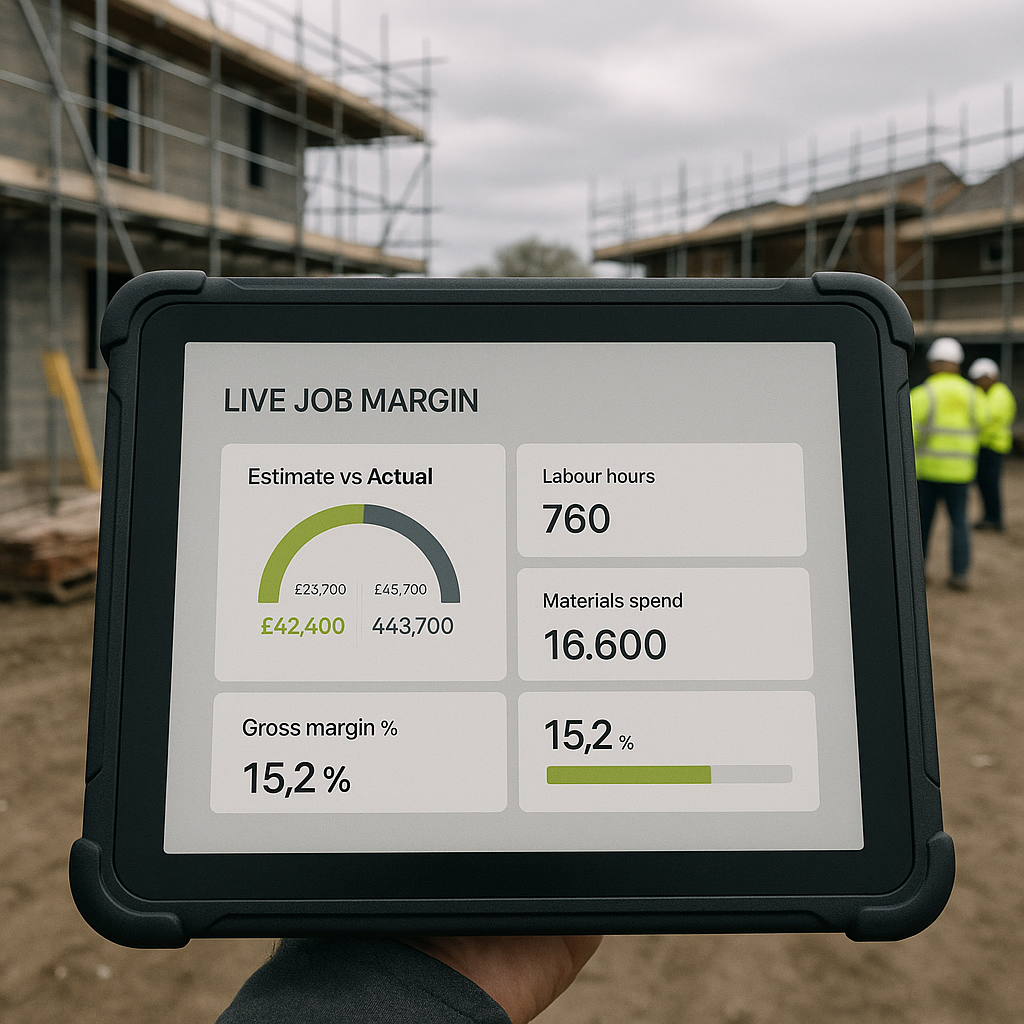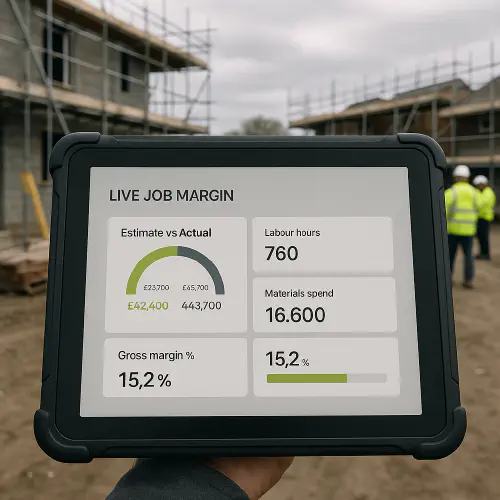
Build a live job margin workflow: Tradify to Xero or QuickBooks without double entry
Build a live job margin workflow: Tradify to Xero or QuickBooks without double entry
Category: Business & Operations • Niche: job costing, live margins, automations, Xero, QuickBooks, Tradify

Site tablet showing live job margin dashboard for UK trades
Contents
- Quick answer
- Who this suits
- How the workflow fits together
- Step-by-step setup
- Daily habits that keep margins accurate
- Checks and reports you should run weekly
- Common UK snags and fixes
- What people are asking
Quick answer
If you price and run jobs in Tradify, you can get live gross margins without manual spreadsheets by:
- Capturing labour in Tradify timesheets with true internal cost rates (not just the charge-out).
- Pushing supplier bills into Xero or QuickBooks, then copying bill lines back to Job Costs in Tradify (SmartRead/Copy Bill Items to Costs).
- Reconciling bank transactions to those bills so your accounting stays in sync.
- Using Tradify’s Job Financial Report to see estimate vs actual, costs not yet invoiced, and gross margin per job.
Do it right and you’ll stop end-of-job surprises and catch overruns early.
Who this suits
- Builders with materials-heavy works and subcontractors.
- Electricians and plumbers doing both quoted and T&M work.
- HVAC firms tracking engineer labour, parts and supplier POs.
- Teams already using Xero or QuickBooks Online and wanting clean, no double entry.
How the workflow fits together
- Tradify holds the job, estimate, tasks and timesheets.
- Xero or QuickBooks holds the supplier bills, VAT, CIS and bank reconciliation.
- Bills are created in accounts software, then copied into Tradify Job Costs.
- Live margin = Tradify estimate vs actual labour + materials + misc costs.
- Invoicing can be from Tradify or accounting; just be consistent per workflow.
Step-by-step setup
1) Tradify settings for accurate labour costs
- Set each staff member’s internal hourly cost in their profile so job gross profit is correct. See Tradify help on calculating costs from timesheets and using the live timer.
- Use quote sections for tasks, then schedule those tasks so time is captured against the right job phase.
Useful: Calculate costs and charges from Timesheets; Add Time/Labour to Jobs Using the Live Timer; Staff Permissions.
2) Materials: bring supplier pricing in and reduce manual entry
- Import supplier price lists to speed quoting and avoid underpricing.
- Use SmartRead to create supplier bills from PDFs/emails, then Copy Bill Items to Costs to feed job actuals.
- Add markup on miscellaneous items so small buys still carry margin.
Useful: Price list management; SmartRead for Bills; Copy Bill Items to Costs; Add Material Costs to Jobs; Add a Mark Up to Miscellaneous items.
3) Connect accounting and decide your invoicing point
- Xero Projects or QuickBooks Projects are optional if Tradify is your job system; most small firms keep job costing in Tradify and invoice from Tradify to Xero/QBO.
- If you invoice from Xero/QBO, turn on Projects and assign costs and time there instead. Don’t try to run two job systems in parallel.
References: Xero Projects job costing pages; QuickBooks Projects help.
4) CIS and VAT DRC basics for UK builders
- If you pay subcontractors, enable CIS in Xero or QuickBooks and follow HMRC rules on verification, deductions and monthly returns.
- If you supply or receive specified construction services, apply the domestic reverse charge VAT where it applies. Check Xero’s DRC guidance.
References: GOV.UK CIS guidance and CIS340; Xero CIS updates; QuickBooks CIS setup; Xero DRC guide.
5) WIP and partial billing
- Tradify does not have a dedicated WIP report. Use the Job Financial Report’s uninvoiced totals to track value on open jobs.
- For stage or progress invoices, stick to one system to avoid duplicate revenue. Record variations as separate tasks or change orders, not comments.
6) Automations to catch overruns early
- Email rules: auto-forward supplier PDFs to your SmartRead address.
- Price changes: maintain supplier price lists quarterly; for high-volume SKUs, use a simple spreadsheet or LiveCosts-type app to monitor changes.
- Alerts: create a weekly report of jobs with margin below target and costs not yet invoiced.
Daily habits that keep margins accurate
- Engineers start and stop timers on every visit. Office checks timesheets daily.
- Raise POs from Tradify before buying to keep costs tied to jobs.
- Reconcile bank daily so bills move from awaiting payment to paid, keeping ledgers tidy.
Checks and reports you should run weekly
- Tradify Job Financial Report: cost vs estimate, margin, costs not invoiced.
- Unbilled time and expenses: make sure all time and receipts are attached to jobs.
- Project profitability by staff: look for under/over recorded labour.
Common UK snags and fixes
- Duplicate job systems: pick Tradify or Xero/QBO Projects for job costing, not both.
- VAT reverse charge on supplier bills: ensure correct tax codes so costs copy cleanly to jobs.
- CIS deductions change gross vs net: understand that CIS affects what you pay subs, not your internal labour cost.
- WIP at year end: export open jobs with uninvoiced totals for your accountant to adjust.
Helpful links
- Tradify: Job Financial Report; WIP reporting note; Timesheets cost vs charge; SmartRead; Copy Bill Items to Costs; Price lists; Staff permissions.
- Xero: Projects job costing; Construction job costing guide; UK pricing; Domestic reverse charge VAT.
- QuickBooks: Projects setup; Track hourly labour costs by project; CIS product page and setup.
- GOV.UK: CIS overview; CIS340 contractor and subcontractor guide; File monthly CIS returns.
- TrainAR Academy: Automate CIS returns from job sheets; Outlook ↔ ServiceM8/Jobber/Tradify calendar sync fixes.
FAQ
Want to slash training times and increase revenue per Engineer? Join our Waitlist: https://trainar.ai/waitlist